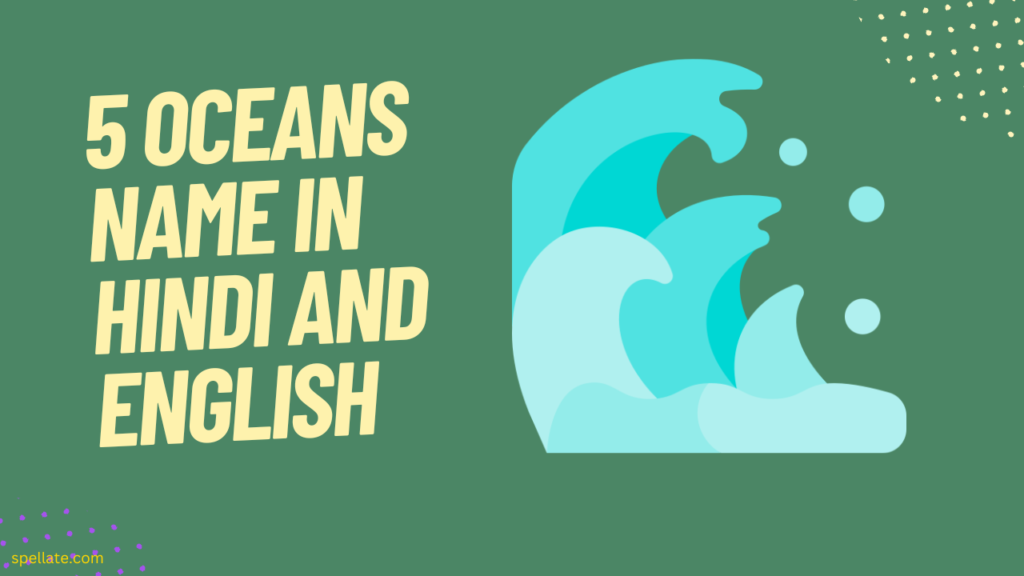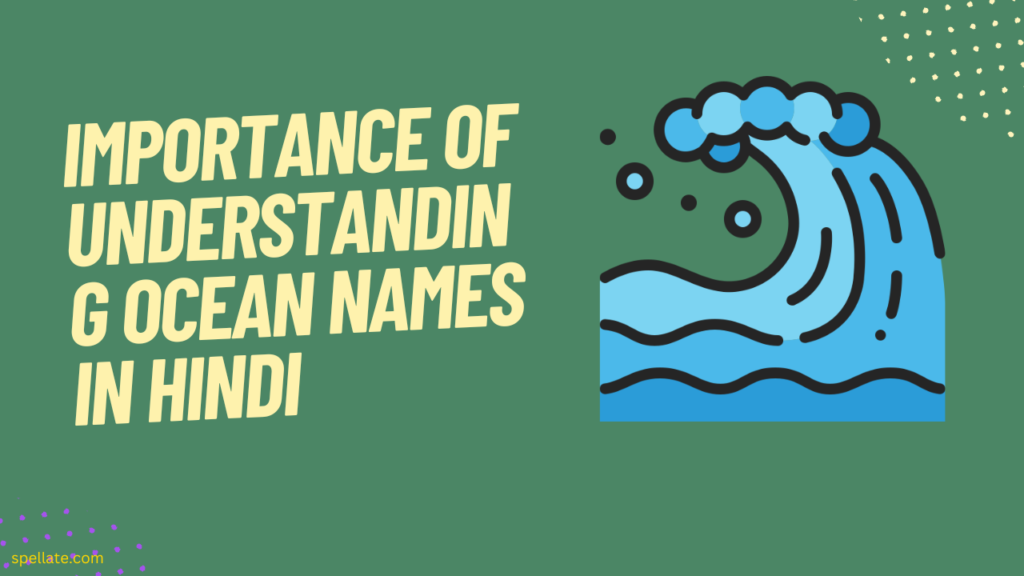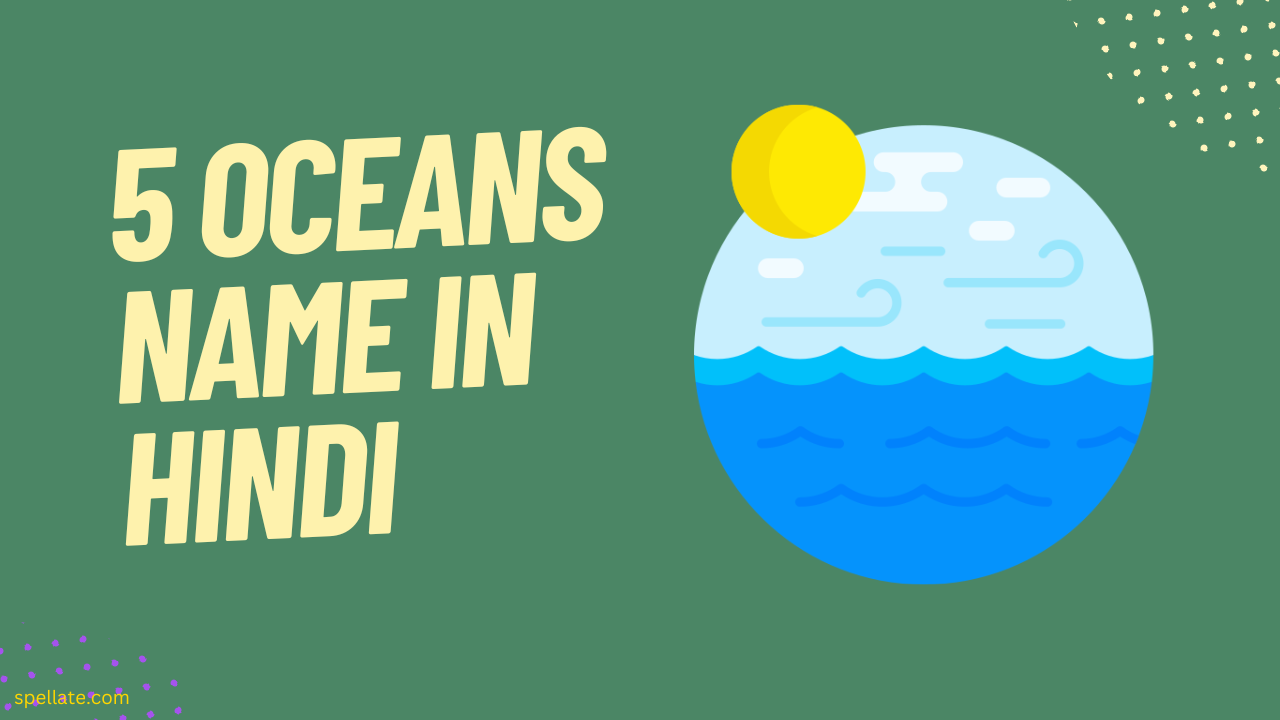The world is home to five magnificent oceans, which are integral parts of our planet’s ecosystem. 5 oceans name in hindi, are known as “पाँच महासागर” or “Paanch Mahasagar.” The five oceans are the Arctic Ocean (आर्कटिक महासागर), the Atlantic Ocean (एटलांटिक महासागर), the Indian Ocean (हिंद महासागर), the Southern Ocean (दक्षिण महासागर), and the Pacific Ocean (प्रशांत महासागर).
The Arctic Ocean is located in the northernmost part of the world, surrounded by Arctic lands. The Atlantic Ocean stretches between the Americas to the west and Europe and Africa to the east. The Indian Ocean lies between Africa, Asia, Australia, and the Indian subcontinent. The Southern Ocean, also known as the Antarctic Ocean, encircles the continent of Antarctica. The Pacific Ocean is the largest and deepest ocean, covering more than one-third of the Earth’s surface, and is located between Asia and Australia to the east and the Americas to the west.
Each of these oceans has its unique characteristics, marine life, and ecosystems, making them vital for our planet’s biodiversity and climate. Exploring these oceans is a fascinating journey that reveals the beauty and power of nature, and the importance of preserving it for future generations.
- 5 oceans name in Hindi and English
- 1. Arctic Ocean – आर्कटिक महासागर (Arctic Mahasagar):
- 2. Atlantic Ocean – एटलांटिक महासागर (Atlantic Mahasagar)
- 3. Indian Ocean – हिंद महासागर (Hind Mahasagar)
- 4. Southern Ocean – दक्षिण महासागर (Dakshin Mahasagar) or अंटार्कटिक महासागर (Antarctic Mahasagar)
- 5. Pacific Ocean – प्रशांत महासागर (Prashant Mahasagar)
- Importance of understanding ocean names in Hindi
- Final Thoughts
- FAQs
5 oceans name in Hindi and English

The world is made up of five oceans, each with their unique characteristics and features. These vast bodies of saltwater are essential to our planet’s ecosystem, providing habitats for a wide range of marine life and regulating the Earth’s climate. Knowing the names of these oceans in both Hindi and English can help us understand and appreciate them better.
1. Arctic Ocean – आर्कटिक महासागर (Arctic Mahasagar):
The Arctic Ocean, also known as the Arctic Sea, is the smallest and shallowest of the world’s five oceans, located at the northernmost part of the Earth. It is bordered by the Arctic lands, including parts of Russia, Canada, Denmark (Greenland), Norway, the United States, Sweden, Finland, and Iceland.
The Arctic Ocean is unique because it is covered by a layer of sea ice for much of the year, which grows during the winter months and recedes in the summer months. The ice cover is an essential habitat for various species, including polar bears, walruses, seals, and numerous fish and invertebrates. The Arctic Ocean is also rich in oil, natural gas, and mineral resources, making it an area of significant economic interest.
The Arctic Ocean plays an essential role in regulating the Earth’s climate, as it reflects sunlight and helps to keep the planet cool. It also affects global ocean circulation, which is critical for the planet’s climate and weather patterns. However, the Arctic Ocean is vulnerable to the impacts of climate change, which are causing the sea ice to melt at an alarming rate, threatening the unique ecosystem and affecting global sea levels.
2. Atlantic Ocean – एटलांटिक महासागर (Atlantic Mahasagar)
The Atlantic Ocean, also known as the Atlantic Sea, is the second-largest ocean on Earth, located between the Americas to the west and Europe, Africa, and the Southern Ocean to the east. It covers approximately one-fifth of the Earth’s surface and is divided into two parts by the Mid-Atlantic Ridge, a chain of underwater mountains that runs down the center of the ocean.
The Atlantic Ocean has played a significant role in human history, as it was a vital trade route for centuries and served as a gateway for exploration and colonization of the Americas. It is also home to diverse marine life, including whales, dolphins, sharks, tuna, and many other fish species, as well as coral reefs, seagrass beds, and other habitats.
The Atlantic Ocean is affected by many natural phenomena, such as hurricanes, ocean currents, and tides, which impact the climate and weather patterns of the surrounding land masses. It is also facing several environmental challenges, including overfishing, pollution, and climate change, which threaten the health of the ocean and its ecosystems. However, international efforts to manage and protect the Atlantic Ocean are underway to ensure its sustainability for future generations.
3. Indian Ocean – हिंद महासागर (Hind Mahasagar)
The Indian Ocean, also known as the Indian Sea, is the third-largest ocean in the world, covering approximately 20% of the Earth’s surface. It is located between Africa, Asia, Australia, and the Indian subcontinent and is connected to the Atlantic Ocean via the southern tip of Africa and the Pacific Ocean through the Indonesian archipelago.
The Indian Ocean is home to a vast array of marine life, including whales, dolphins, sharks, turtles, and numerous fish and invertebrates. It is also home to many coral reefs, seagrass meadows, and other important habitats. The ocean’s biodiversity is critical for sustaining the livelihoods of millions of people living in the surrounding countries, who depend on fishing and tourism as a source of income.
The Indian Ocean is also an important trade route, connecting Europe, Africa, and Asia. It has a long history of cultural exchange, as it has been a hub for trade and commerce for thousands of years. The ocean is also affected by various natural phenomena, such as monsoons, cyclones, and tsunamis, which can impact the surrounding coastal areas.
Like other oceans, the Indian Ocean is facing several environmental challenges, including overfishing, plastic pollution, and climate change, which are affecting the health of its ecosystems. International efforts are underway to manage and protect the ocean and its resources, ensuring their sustainability for future generations.
4. Southern Ocean – दक्षिण महासागर (Dakshin Mahasagar) or अंटार्कटिक महासागर (Antarctic Mahasagar)
The Southern Ocean, also known as the Antarctic Ocean or the South Polar Ocean, is the smallest and youngest of the world’s five oceans, surrounding Antarctica and extending north to 60 degrees south latitude. It was officially recognized as a distinct ocean by the International Hydrographic Organization in 2000.
The Southern Ocean is unique because it is the only ocean that circulates around the Earth unimpeded by any landmass. It is characterized by strong ocean currents, including the Antarctic Circumpolar Current, which flows from west to east around Antarctica, transporting cold and nutrient-rich water throughout the ocean. The ocean’s unique oceanographic conditions and isolation have led to the evolution of unique marine life, such as penguins, seals, and krill, which are essential for the Antarctic food web.
The Southern Ocean plays a vital role in regulating the Earth’s climate and global ocean circulation. It also acts as a carbon sink, absorbing significant amounts of carbon dioxide from the atmosphere, which helps to mitigate the impacts of climate change.
Despite its remote location, the Southern Ocean is facing various environmental challenges, such as overfishing, plastic pollution, and climate change, which are affecting the ocean’s unique ecosystem. International efforts to protect the Southern Ocean and its resources are underway to ensure its sustainability for future generations.
You May Also Like
5. Pacific Ocean – प्रशांत महासागर (Prashant Mahasagar)
The Pacific Ocean, also known as the Pacific Sea, is the largest and deepest ocean in the world, covering approximately one-third of the Earth’s surface. It is located between the Americas to the east and Asia and Australia to the west and is bounded by the Arctic and Antarctic regions to the north and south, respectively.
The Pacific Ocean is home to a diverse range of marine life, including whales, dolphins, sharks, sea turtles, and countless fish and invertebrate species. It also contains many coral reefs, seagrass meadows, and other important habitats that support the ocean’s biodiversity. The ocean is also a vital source of food and livelihood for millions of people who depend on fishing and other ocean-related industries.
The Pacific Ocean is also a critical trade route, linking Asia, the Americas, and Oceania. It has played a significant role in the history of human migration and exploration, as well as in military operations and strategic planning.
The Pacific Ocean is affected by various natural phenomena, such as ocean currents, tides, and typhoons, which can impact the climate and weather patterns of the surrounding land masses. The ocean is also facing several environmental challenges, including overfishing, pollution, and climate change, which threaten the health of its ecosystems.
International efforts to manage and protect the Pacific Ocean are underway, including the establishment of marine protected areas and the adoption of sustainable fishing practices. These efforts aim to ensure the ocean’s sustainability for future generations and promote the conservation of its unique biodiversity.
Importance of understanding ocean names in Hindi

Understanding the 5 oceans name in Hindi is essential for promoting awareness and education about these vast bodies of water among Hindi-speaking populations around the world. It allows people to learn about the oceans’ geographic features, marine life, and unique characteristics in their native language, which can help to deepen their appreciation and understanding of the oceans.
For instance, knowing the Hindi names of the oceans can help people understand the significance of these vast bodies of water for trade, transportation, and the global economy. It can also enable them to appreciate the crucial role that oceans play in regulating the Earth’s climate and sustaining life on the planet.
Additionally, understanding ocean names in Hindi can help people better comprehend the environmental challenges that oceans are facing, such as overfishing, pollution, and climate change, which threaten their health and the livelihoods of millions of people who depend on them. It can also encourage people to take action to protect the oceans and promote sustainable practices that ensure their long-term sustainability.
Overall, understanding the 5 oceans name in Hindi can promote ocean literacy and help people appreciate the oceans’ critical role in shaping our planet’s past, present, and future.
Final Thoughts
In conclusion, understanding ocean names in Hindi is vital for promoting ocean literacy and raising awareness about the significance of these vast bodies of water among Hindi-speaking populations worldwide. The oceans play a crucial role in regulating the Earth’s climate, sustaining life, and supporting economies and trade, making it essential for people to comprehend their unique characteristics and challenges.
By learning about the oceans in their native language, people can deepen their understanding and appreciation of their importance and take action to protect them for future generations. Therefore, it is crucial to continue promoting education and awareness about the oceans’ significance and encourage sustainable practices that ensure their long-term sustainability.
FAQs
What are the 3 types of seas?
Marginal seas: These are the seas that are located along the margins of the continents, usually separated from the open ocean by a chain of islands or a continental shelf. Examples of marginal seas include the Mediterranean Sea, the Red Sea, and the Persian Gulf.
Intercontinental seas: These are the seas that are located between two continents and are usually connected to the oceans. The largest intercontinental sea is the Mediterranean Sea, which is bordered by Europe, Africa, and Asia.
Inland seas: These are the seas that are entirely enclosed by land and have no direct connection to the ocean. The largest inland sea is the Caspian Sea, which is located between Europe and Asia.
What is the significance of the Indian Ocean in Hindi culture and history?
The Indian Ocean has played a significant role in the history, culture, and trade of India for centuries. The ocean’s warm waters and favorable monsoon winds facilitated trade and cultural exchange between India and other parts of the world.
How are the five oceans different from each other in Hindi?
The five oceans differ in their size, depth, temperature, and marine life. Each ocean has its unique features and characteristics.
